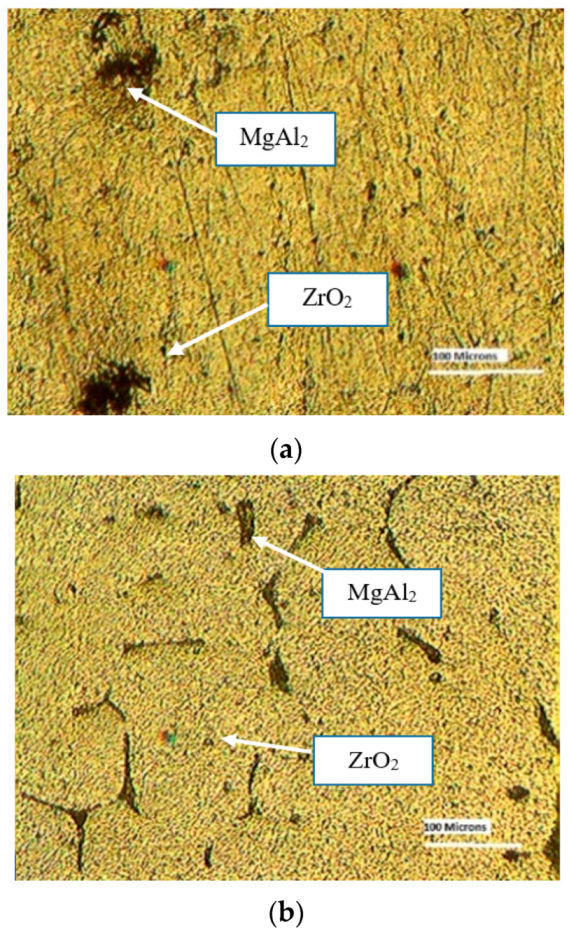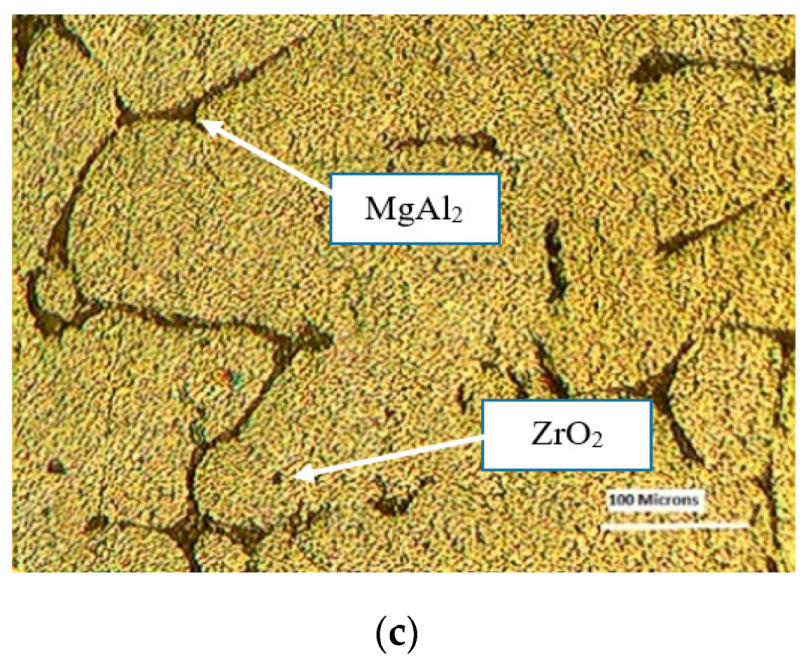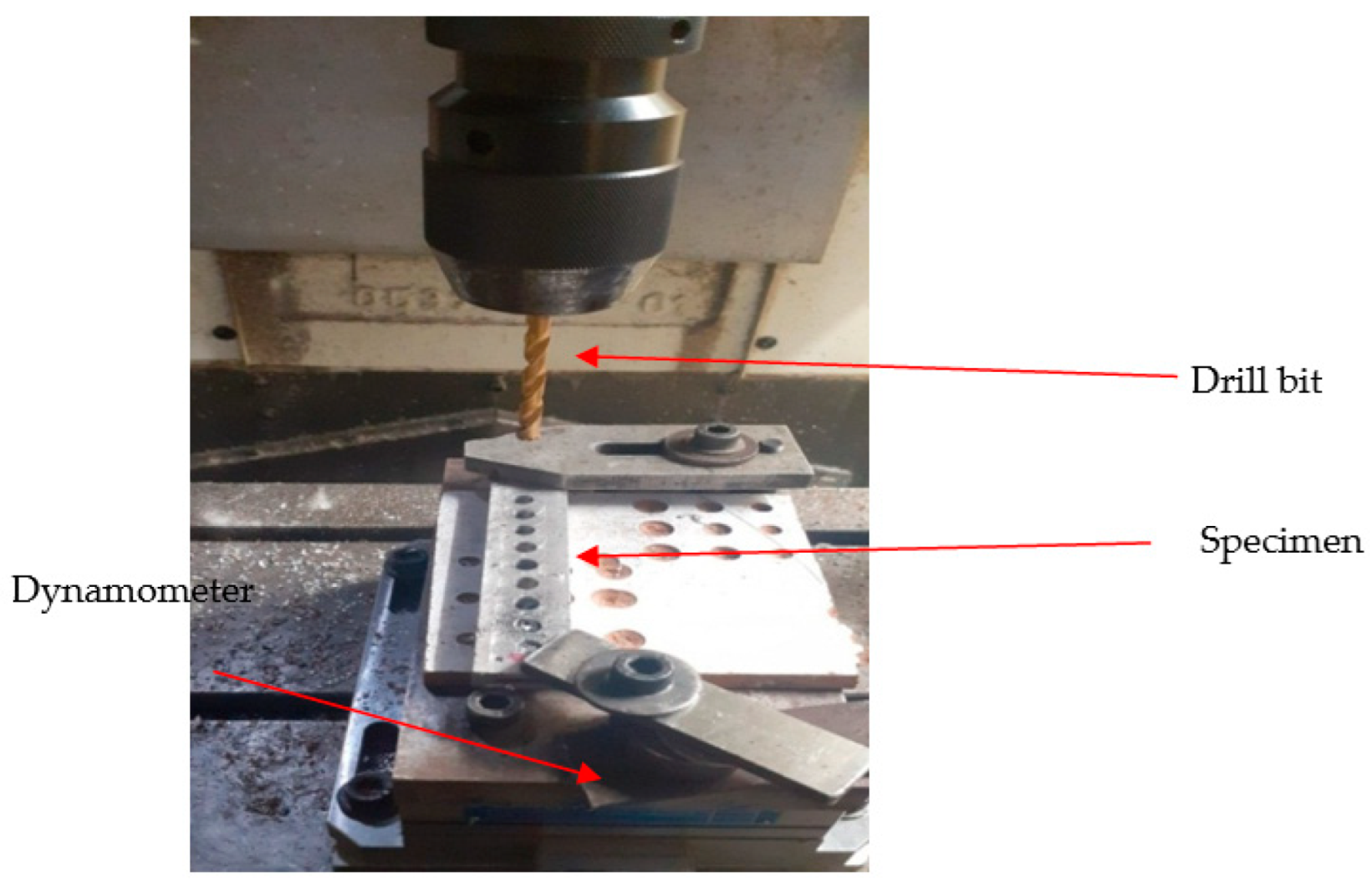Multi-Objective Optimization of Machining Parameters for Drilling LM5/ZrO2 Composites Using Grey Relational Analysis
Abstract
:1. Introduction
2. Materials and Methods
2.1. Materials
2.2. Manufacturing of LM5/ZrO2 Composites
2.3. Microstructure of Fabricated Composites Using Optical Microscopy
2.4. Drilling of LM5/ZrO2Composites
2.5. Grey Relational Analysis
2.6. Grey Relational Coefficient (GRC)
2.7. Grey Relational Grade (GRG)
2.8. Predicting the Optimal Responses
3. Results and Discussions
3.1. Experimental Results
3.2. Analysis and Discussion of Results
3.3. Confirmation Experiments
3.4. Influence of Input Variables on GRG
3.5. Mathematical Models
4. Conclusions
Author Contributions
Funding
Institutional Review Board Statement
Informed Consent Statement
Data Availability Statement
Conflicts of Interest
References
- Shivatsan, T.S.; Ibrahim, T.S.; Mehmed, F.A.; Lavernia, E.J. Processing techniques for particulate-reinforced metal aluminium matrix composites. J. Mater. Sci. 1991, 26, 5965–5978. [Google Scholar] [CrossRef]
- Hashim, J.; Looney, L.; Hashmi, M.S.J. The enhancement of wettability of SiC particles in cast aluminium matrix composites. J. Mater. Process. Technol. 1999, 119, 329–335. [Google Scholar] [CrossRef]
- Nturanabo, F.; Masu, L.; Kirabira, J.B. Novel Applications of Aluminium Metal Matrix Composites; IntechOpen: London, UK, 2019. [Google Scholar]
- Prakash, J.U.; Ananth, S.; Sivakumar, G.; Moorthy, T.V. Multi-Objective Optimization of Wear Parameters for Aluminium Matrix Composites (413/B4C) using Grey Relational Analysis. Mater. Today Proc. 2018, 5, 7207–7216. [Google Scholar] [CrossRef]
- Davim, J.P.; Antonio, C.A.C. Optimization of cutting conditions in machining of aluminium matrix composites using a numerical and experimental model. J. Mater. Process. Technol. 2001, 112, 78–82. [Google Scholar] [CrossRef]
- Prakash, J.U.; Rubi, C.S.; Rajkumar, C.; Juliyana, S.J. Multi-objective drilling parameter optimization of hybrid metal matrix composites using grey relational analysis. Mater. Today Proc. 2020, 39, 1345–1350. [Google Scholar] [CrossRef]
- Haq, A.N.; Marimuthu, P.; Jeyapaul, R. Multi response optimization of machining parameters of drilling Al/SiC metal matrix composite using grey relational analysis in the Taguchi method. Int. J. Adv. Manuf. Technol. 2008, 37, 250–255. [Google Scholar] [CrossRef]
- Ponnuvel, S.; Moorthy, T. Multi-Criteria Optimisation in Drilling of Epoxy/Glass Fabric Hybrid Nanocomposite Using Grey Relational Analysis. Appl. Mech. Mater. 2014, 446–447, 172–175. [Google Scholar] [CrossRef]
- Rajmohan, T.; Palanikumar, K.; Prakash, S. Grey-fuzzy algorithm to optimise machining parameters in drilling of hybrid metal matrix composites. Compos. Part B Eng. 2013, 50, 297–308. [Google Scholar] [CrossRef]
- Salura, E.; Aslanb, A.; Kuntoglub, M.; Gunesc, A.; Sahin, O.S. Experimental study and analysis of machinability characteristics of metal matrix composites during drilling. Compos. Part B 2019, 166, 401–413. [Google Scholar] [CrossRef]
- Palanikumar, K.; Muniaraj, A. Experimental investigation and analysis of thrust force in drilling cast hybrid metal matrix (Al–15% SiC–4% graphite) composites. Measurement 2014, 53, 240–250. [Google Scholar] [CrossRef]
- Davim, J.P. A note on the determination of optimal cutting conditions for surface finish obtained in turning using design of experiments. J. Mater. Process. Technol. 2001, 116, 305–308. [Google Scholar] [CrossRef]
- Samy, G.S.; Kumaran, S.T. Measurement and analysis of temperature, thrust force and surface roughness in drilling of AA (6351)-B4C composite. Measurement 2017, 103, 1–9. [Google Scholar] [CrossRef]
- Xiang, J.; Xiea, L.; Gao, F.; Yia, J.; Panga, S.; Wang, X. Diamond tools wear in drilling of SiCp/Al matrix composites containing Copper. Ceram. Int. 2017, 44, 5341–5351. [Google Scholar] [CrossRef]
- Jayaganth, A.; Jayakumar, K.; Deepak, A.; Pazhanivel, K. Experimental studies on drilling of 410 stainless steel. Mater. Today Proc. 2018, 5, 7168–7173. [Google Scholar] [CrossRef]
- Mahamani, A. Experimental investigation on drilling of AA2219-TiB2/ZrB2 In-situ metal matrix composites. Procedia Mater. Sci. 2014, 6, 950–960. [Google Scholar] [CrossRef]
- Ekici, E.; Motorcu, A.R.; Uzun, G. An investigation of the effects of cutting parameters and graphite reinforcement on quality characteristics during the drilling of Al/10B4C composites. Measurement 2017, 95, 395–404. [Google Scholar] [CrossRef]
- Ravindranath, V.M.; Yerriswamy, M.; Vivek, S.V.; Shankar, G.S.; Kumar, N.S. Drilling of Al2219/B4C/Gr metal matrix hybrid composites. Mater. Today Proc. 2017, 4, 9898–9901. [Google Scholar] [CrossRef]
- Ankalagi, S.; Gaitonde, V.N.; Petkar, P. Experimental Studies on Hole Quality in Drilling of SA182 Steel. Mater. Today Proc. 2017, 4, 11201–11209. [Google Scholar] [CrossRef]
- Juliyana, S.J.; Prakash, J.U.; SachinSalunkhe; Hussein, H.M.A.; Gawade, S.R. Mechanical Characterization and Microstructural Analysis of Hybrid Composites (LM5/ZrO2/Gr). Crystals 2022, 12, 1207. [Google Scholar] [CrossRef]
- Rubi, C.S.; Prakash, J.U.; Čep, R.; Elangovan, M. Optimization of Process Variables in the Drilling of LM6/B4C Composites through Grey Relational Analysis. Materials 2022, 15, 4860. [Google Scholar] [CrossRef]
- Doreswamy, D.; Shreyas, D.S.; Bhat, S.K.; Rao, R.N. Optimization of material removal rate and surfacecharacterization of wire electric discharge machined Ti-6Al-4V alloy by response surface method. Manuf. Rev. 2022, 9, 15. [Google Scholar]
- Adiga, K.; Herbert, M.A.; Rao, S.S.; Shettigar, A. Applications of reinforcement particles in the fabrication of Aluminium Metal Matrix Composites by Friction Stir Processing—A Review. Manuf. Rev. 2022, 9, 26. [Google Scholar] [CrossRef]
- Prakash, J.U.; Rubi, C.S.; Palani, S.; Juliyana, S.J. Optimization of machining parameters in drilling of LM6/B4C/Fly ash hybrid composites. Manuf. Rev. 2022, 9, 28. [Google Scholar] [CrossRef]
- Kuntoğlu, M.; Aslan, A.; Pimenov, D.Y.; Usca, Ü.A.; Salur, E.; Gupta, M.K.; Mikolajczyk, T.; Giasin, K.; Kapłonek, W.; Sharma, S. A review of indirect tool condition monitoring systems and decision-making methods in turning: Critical analysis and trends. Sensors 2020, 21, 108. [Google Scholar] [CrossRef]
- Aslan, A. Optimization and analysis of process parameters for flank wear, cutting forces and vibration in turning of AISI 5140: A comprehensive study. Measurement 2020, 163, 107959. [Google Scholar] [CrossRef]
- Usca, Ü.A.; Şap, S.; Uzun, M.; Kuntoğlu, M.; Salur, E.; Karabiber, A.; Pimenov, D.Y.; Giasin, K.; Wojciechowski, S. Estimation, optimization and analysis based investigation of the energy consumption in machinability of ceramic-based metal matrix composite materials. J. Mater. Res. Technol. 2022, 17, 2987–2998. [Google Scholar] [CrossRef]
- Durão, L.M.P.; Tavares, J.M.R.; De Albuquerque, V.H.C.; Marques, J.F.S.; Andrade, O.N. Drilling damage in composite material. Materials 2014, 7, 3802–3819. [Google Scholar] [CrossRef]
- Caggiano, A.; Improta, I.; Nele, L. Characterization of a new dry drill-milling process of carbon fibre reinforced polymer laminates. Materials 2018, 11, 1470. [Google Scholar] [CrossRef]
- Uddin, M.; Basak, A.; Pramanik, A.; Singh, S.; Krolczyk, G.M.; Prakash, C. Evaluating hole quality in drilling of Al 6061 alloys. Materials 2018, 11, 2443. [Google Scholar] [CrossRef]
- Aamir, M.; Tu, S.; Tolouei-Rad, M.; Giasin, K.; Vafadar, A. Optimization and modeling of process parameters in multi-hole simultaneous drilling using taguchi method and fuzzy logic approach. Materials 2020, 13, 680. [Google Scholar] [CrossRef]
- Parasuraman, S.; Elamvazuthi, I.; Kanagaraj, G.; Natarajan, E.; Pugazhenthi, A. Assessments of process parameters on cutting force and surface roughness during drilling of AA7075/TiB2 in situ composite. Materials 2020, 14, 1726. [Google Scholar] [CrossRef] [PubMed]
- Franczyk, E.; Ślusarczyk, Ł.; Zębala, W. Drilling Burr minimization by changing drill geometry. Materials 2020, 13, 3207. [Google Scholar] [CrossRef]
- Jebarose Juliyana, S.; Udaya Prakash, J. Drilling parameter optimization of metal matrix composites (LM5/ZrO2) using Taguchi Technique. Mater. Today Proc. 2020, 33, 3046–3050. [Google Scholar] [CrossRef]
- Ananth, S.; Udaya Prakash, J.; Moorthy, T.V.; Hariharan, P. Optimization of Wear Parameters for Grey Cast Iron under Different Conditions using Grey Relational Analysis. Mater. Today Proc. 2018, 5, 7346–7354. [Google Scholar] [CrossRef]







| Cu | Mg | Si | Mn | Fe | Pb | Zn | Al |
|---|---|---|---|---|---|---|---|
| 0.032 | 3.299 | 0.212 | 0.022 | 0.268 | 0.02 | 0.01 | Balance |
| Factor | Level 1 | Level 2 | Level 3 |
|---|---|---|---|
| F (mm/min) | 50 | 100 | 150 |
| S (rpm) | 1000 | 2000 | 3000 |
| D | HSS | Carbide | TiN Coated |
| R (%) | 3 | 6 | 9 |
| Sl No | Feed (mm/min) | Speed (rpm) | Drill Material | Reinforcement (wt %) | GRC of TF | GRC of SR | GRC of BH | GRG | Rank |
|---|---|---|---|---|---|---|---|---|---|
| 1 | 50 | 1000 | HSS | 3 | 0.655 | 0.654 | 0.678 | 0.662 | 11 |
| 2 | 50 | 1000 | Carbide | 6 | 0.615 | 0.744 | 0.695 | 0.685 | 10 |
| 3 | 50 | 1000 | TiN Coated | 9 | 0.612 | 0.499 | 0.781 | 0.631 | 13 |
| 4 | 50 | 2000 | HSS | 6 | 0.7 | 0.434 | 0.648 | 0.594 | 17 |
| 5 | 50 | 2000 | Carbide | 9 | 0.84 | 0.744 | 0.496 | 0.693 | 9 |
| 6 | 50 | 2000 | TiN Coated | 3 | 0.904 | 0.433 | 0.76 | 0.699 | 8 |
| 7 | 50 | 3000 | HSS | 9 | 0.716 | 0.418 | 0.695 | 0.610 | 16 |
| 8 | 50 | 3000 | Carbide | 3 | 0.969 | 0.702 | 0.678 | 0.783 | 2 |
| 9 | 50 | 3000 | TiN Coated | 6 | 1 | 0.747 | 1 | 0.916 | 1 |
| 10 | 100 | 1000 | HSS | 3 | 0.481 | 0.436 | 0.678 | 0.532 | 24 |
| 11 | 100 | 1000 | Carbide | 6 | 0.421 | 1 | 0.864 | 0.762 | 3 |
| 12 | 100 | 1000 | TiN Coated | 9 | 0.454 | 0.583 | 0.695 | 0.577 | 19 |
| 13 | 100 | 2000 | HSS | 6 | 0.704 | 0.462 | 0.333 | 0.500 | 27 |
| 14 | 100 | 2000 | Carbide | 9 | 0.625 | 0.758 | 0.741 | 0.708 | 5 |
| 15 | 100 | 2000 | TiN Coated | 3 | 0.7 | 0.392 | 0.509 | 0.534 | 23 |
| 16 | 100 | 3000 | HSS | 9 | 0.652 | 0.468 | 0.760 | 0.627 | 14 |
| 17 | 100 | 3000 | Carbide | 3 | 0.846 | 0.581 | 0.678 | 0.702 | 7 |
| 18 | 100 | 3000 | TiN Coated | 6 | 0.762 | 0.487 | 0.935 | 0.728 | 4 |
| 19 | 150 | 1000 | HSS | 3 | 0.358 | 0.595 | 0.581 | 0.511 | 26 |
| 20 | 150 | 1000 | Carbide | 6 | 0.348 | 0.414 | 0.891 | 0.551 | 20 |
| 21 | 150 | 1000 | TiN Coated | 9 | 0.333 | 0.559 | 0.85 | 0.581 | 18 |
| 22 | 150 | 2000 | HSS | 6 | 0.53 | 0.411 | 0.634 | 0.525 | 25 |
| 23 | 150 | 2000 | Carbide | 9 | 0.497 | 0.522 | 0.634 | 0.551 | 21 |
| 24 | 150 | 2000 | TiN Coated | 3 | 0.577 | 0.516 | 0.77 | 0.621 | 15 |
| 25 | 150 | 3000 | HSS | 9 | 0.673 | 0.333 | 0.62 | 0.542 | 22 |
| 26 | 150 | 3000 | Carbide | 3 | 0.747 | 0.522 | 0.85 | 0.706 | 6 |
| 27 | 150 | 3000 | TiN Coated | 6 | 0.704 | 0.581 | 0.695 | 0.66 | 12 |
| Level | Feed Rate (F) | Spindle Speed (S) | Drill Material (D) | Reinforcement% (R) |
|---|---|---|---|---|
| 1 | 0.6970 | 0.6102 | 0.5670 | 0.6389 |
| 2 | 0.6300 | 0.6028 | 0.6823 | 0.6579 |
| 3 | 0.5831 | 0.6971 | 0.6608 | 0.6133 |
| Delta | 0.1139 | 0.0943 | 0.1153 | 0.0446 |
| Rank | 2 | 3 | 1 | 4 |
| Source of Variation | DOF | SS | MS | F | p | C% |
|---|---|---|---|---|---|---|
| Feed Rate | 2 | 10.574 | 5.2871 | 9.93 | 0.002 | 24.24 |
| Spindle Speed | 2 | 8.516 | 4.2582 | 8.00 | 0.004 | 19.52 |
| Drill Material | 2 | 12.688 | 6.3442 | 11.92 | 0.001 | 29.08 |
| Feed rate*Drill Material | 4 | 3.326 | 0.8315 | 1.56 | 0.232 | 7.62 |
| Pooled Error | 16 | 8.519 | 0.5324 | 19.53 | ||
| Total | 26 | 43.624 | 100.00 |
Disclaimer/Publisher’s Note: The statements, opinions and data contained in all publications are solely those of the individual author(s) and contributor(s) and not of MDPI and/or the editor(s). MDPI and/or the editor(s) disclaim responsibility for any injury to people or property resulting from any ideas, methods, instructions or products referred to in the content. |
© 2023 by the authors. Licensee MDPI, Basel, Switzerland. This article is an open access article distributed under the terms and conditions of the Creative Commons Attribution (CC BY) license (https://creativecommons.org/licenses/by/4.0/).
Share and Cite
Jebarose Juliyana, S.; Udaya Prakash, J.; Čep, R.; Karthik, K. Multi-Objective Optimization of Machining Parameters for Drilling LM5/ZrO2 Composites Using Grey Relational Analysis. Materials 2023, 16, 3615. https://doi.org/10.3390/ma16103615
Jebarose Juliyana S, Udaya Prakash J, Čep R, Karthik K. Multi-Objective Optimization of Machining Parameters for Drilling LM5/ZrO2 Composites Using Grey Relational Analysis. Materials. 2023; 16(10):3615. https://doi.org/10.3390/ma16103615
Chicago/Turabian StyleJebarose Juliyana, Sunder, Jayavelu Udaya Prakash, Robert Čep, and Krishnasamy Karthik. 2023. "Multi-Objective Optimization of Machining Parameters for Drilling LM5/ZrO2 Composites Using Grey Relational Analysis" Materials 16, no. 10: 3615. https://doi.org/10.3390/ma16103615






